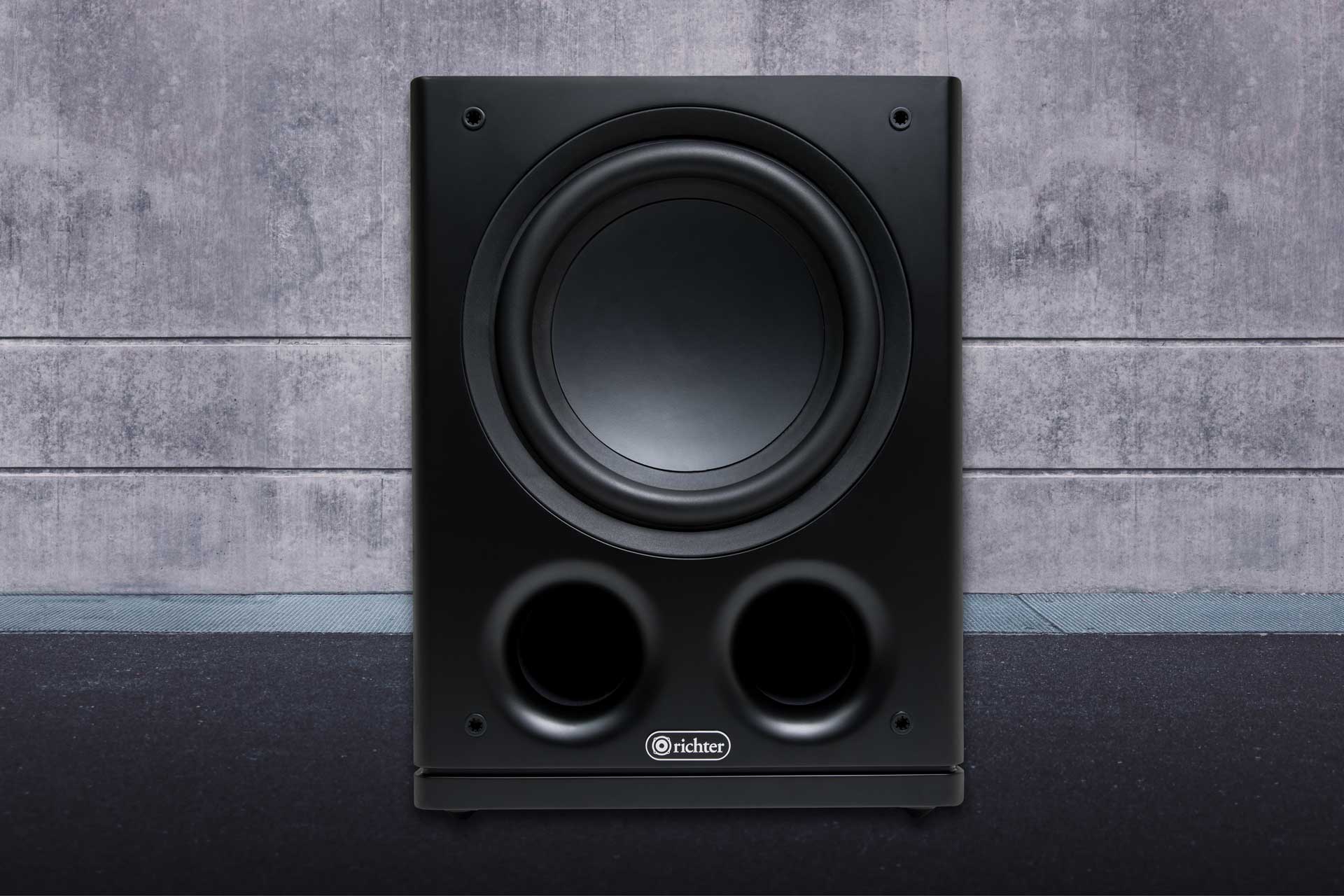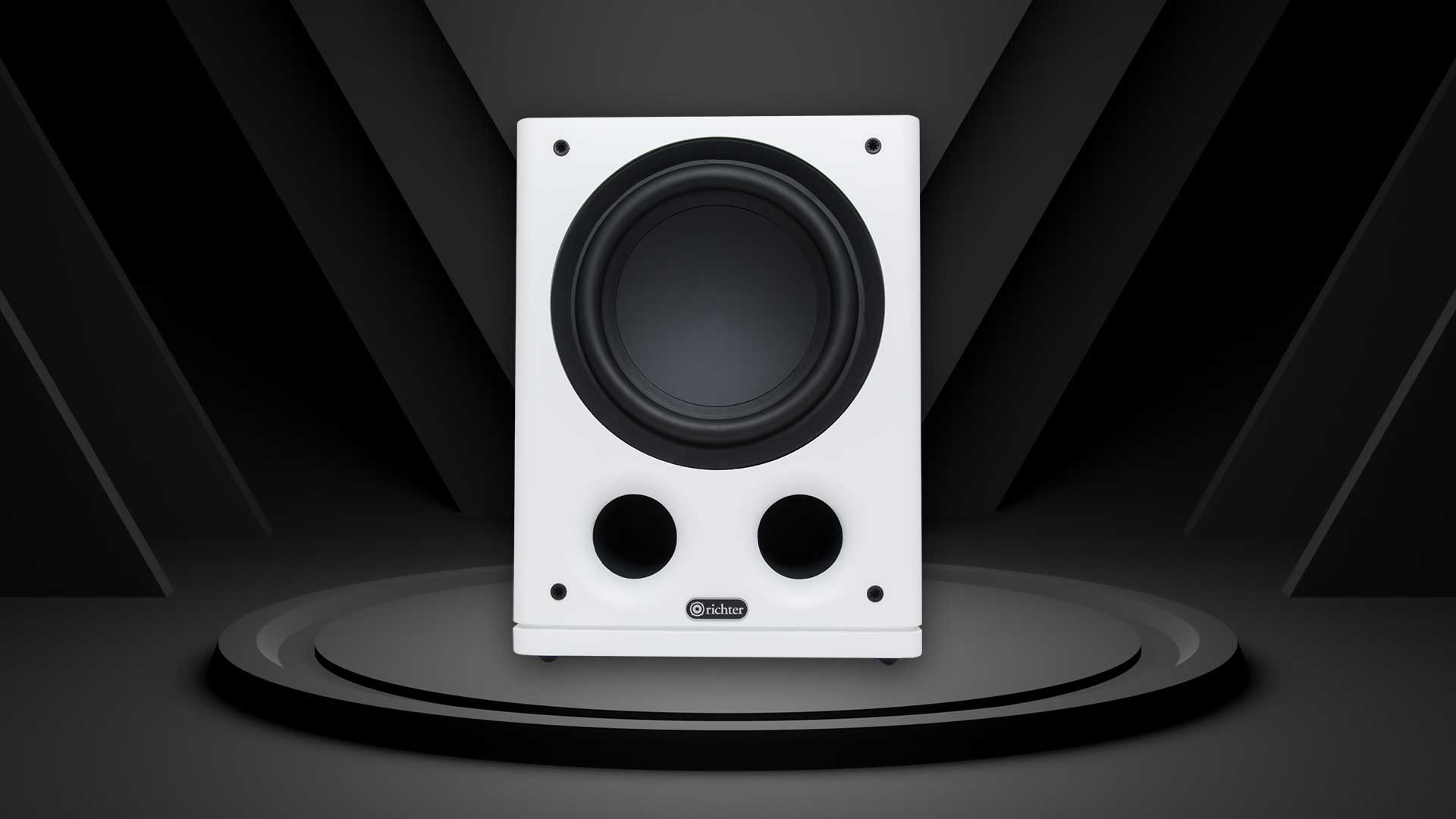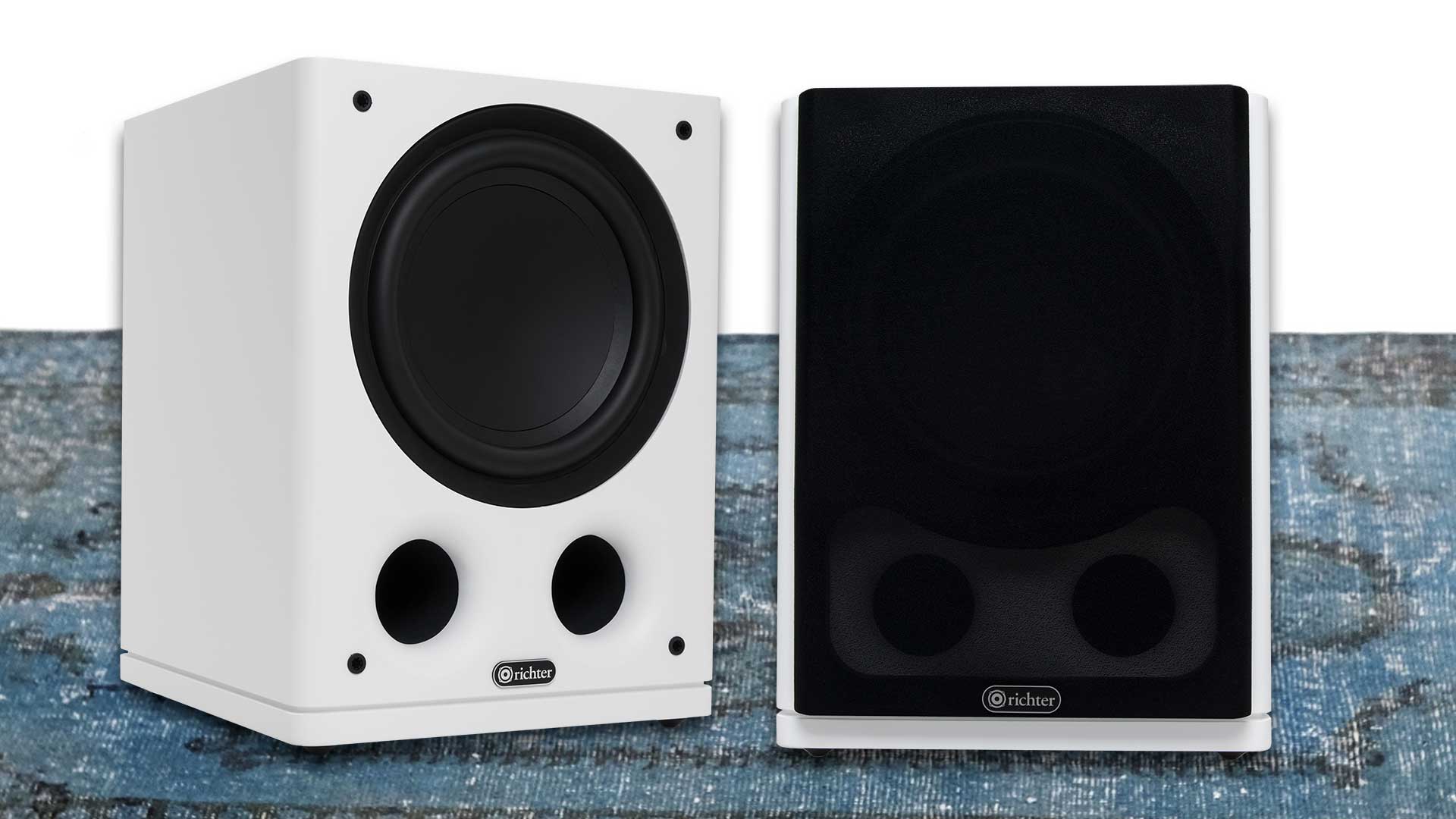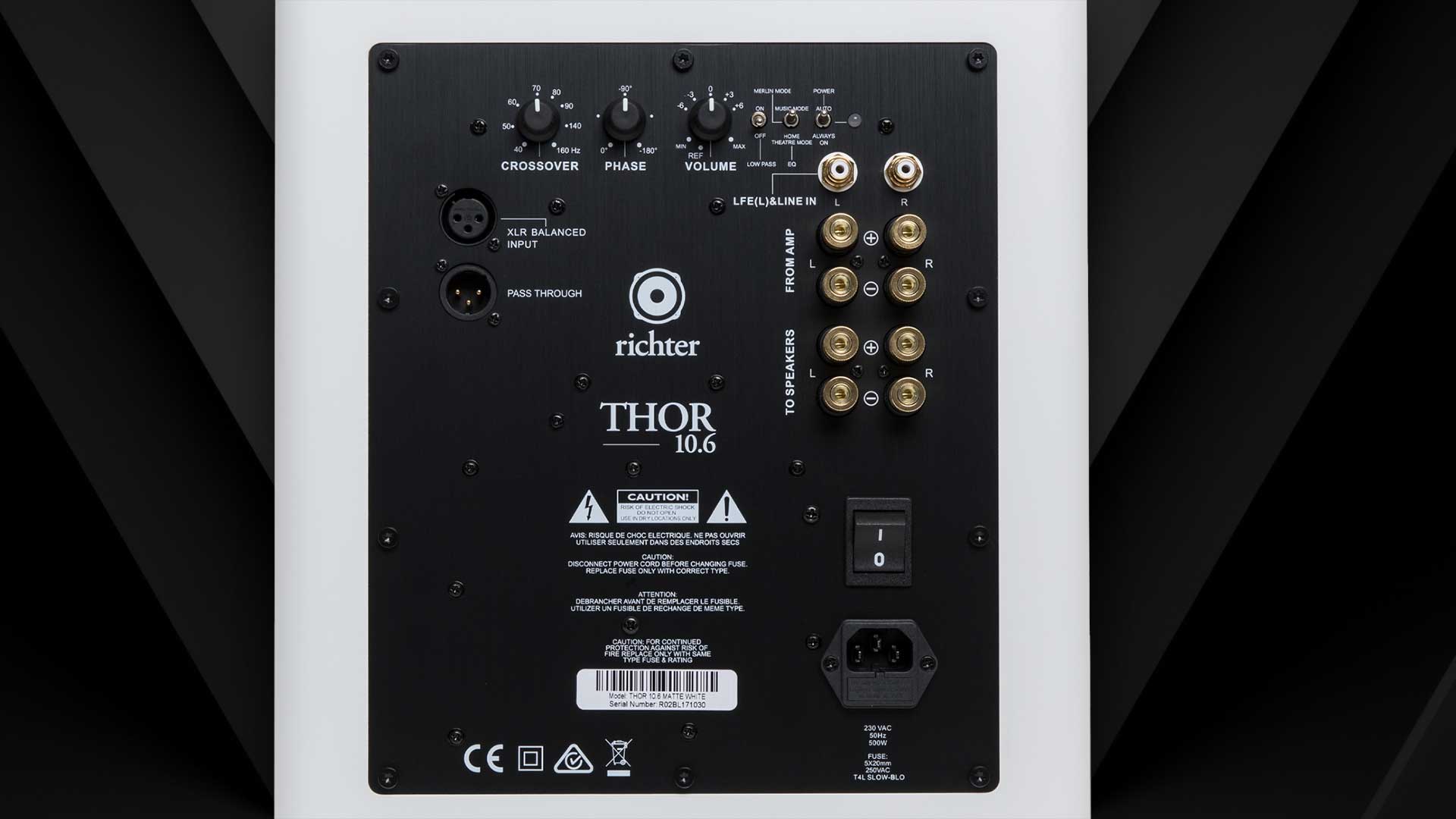What Hi-Fi? Verdict
Richter delivers a compact subwoofer offering what its market research found Australians want – good connectivity including preset EQ modes, a compact room-friendly design, and enough high-quality bass to fully fill out a stereo or multichannel system.
Pros
- +
Amazing bass!
- +
Versatility through connectivity
- +
Useful EQ modes
- +
White as well as black
Cons
- -
Grille is black only
Why you can trust What Hi-Fi?

This review originally appeared in Sound+Image magazine, one of What Hi-Fi?’s Australian sister publications. Click here for more information on Sound+Image, including digital editions and details on how you can subscribe.
Richter is an Australian brand that has held to its fundamental goals ever since Ralph Waters founded the company in 1986. As Richter’s managing director today, Brian Rodgers, says: “Richter’s philosophy from the beginning was this: ‘We never stop improving what we make. Good design is the key to success. And a successful product must be long lasting and offer value for money.’”
And when researching the market for this product, the latest in Richter’s legendary line of Thor subwoofers, he was able to add a few more truisms to the list: ‘big is bad’, ‘ports are poxy’, and ‘vinyl sucks’ — this last referring not to a dislike for LP records, we’re pleased to say, but to the modern disregard for vinyl-wrapped speaker finishes.
These were the notes with which Brian Rodgers returned from a tour of Australian hi-fi retailers. The consensus was that customers wanted subwoofers that were small, they didn’t like bass reflex ports to be visible, and they didn’t like vinyl finishes due to a perception of splitting and peeling at the corners.
So he tasked his Senior Engineer Dr Martin Gosnell with development of a Richter subwoofer design for the latest Series 6, smaller and lighter than the company’s previous multi-award-winning Thor subs, to be either a sealed design or with bass reflex ports that customers wouldn’t be able to see… and in any practicable finish he liked, so long as it wasn’t vinyl.

Equipment

Design: Front-ported bass reflex with port tuning
Inputs: 2 x RCA line level (inc. 1 x LFE); XLR passthrough, speaker-level in and out
Driver: 10-inch high excursion
Power: 450W RMS Class-D
Dimensions (hwd): 430 x 329 x 365mm with grille
Weight: 19.5kg
The arrival of the Thor 10.6 proved that Dr Gosnell met the design brief admirably, and he increased the internal power as well.
The 10.6 is 20% smaller than the previous Thor MkV, and it’s 30% cent lighter. Its amplifier is rated at 450W compared to the 300W amplifier inside the previous MkV. If you leave the grille on, you can’t see the twin (tuneable!) bass reflex ports. And no vinyl to be seen, just a very classy matte-painted surface that when in black it's so black it’s probably the same finish that was used on Hotblack Desiato’s stunt ship. (You know, the one Zaphod Beeblebrox ‘borrowed.’)
But you can optionally order the Thor 10.6 in a matte white finish, though the front grille cloth remains black.
The latest hi-fi, home cinema and tech news, reviews, buying advice and deals, direct to your inbox.
With the grille off (we don’t mind ports here), you instantly see this subwoofer’s most imposing feature, a dish-shaped polymer cone with an unusually distinctive neoprene roll surround that was tooled by Richter itself. Richter rates this driver at 10 inches diameter, which is the ‘10’ part of the10.6 model name, while the ‘6’ shows that it’s part of Richter’s ‘6 Series’.
So why the front ports, and two of them, given the ‘no ports’ directive?
Well for one thing they can be hidden behind the front grille. In addition, front ports, rather than on the side (like some earlier Richter models) or at the back or underneath, mean you can completely remove the subwoofer from the listening room, recessed into a wall, cupboard or cabinet. Or you might think it’s so small in your room that there’s no need to go to such lengths, especially as its design of being higher than it is wide further assists its integration into room décor.
As mentioned, those bass reflex ports are tuneable. Each port is 75mm in diameter and 225mm long, with radiused curves at the exit, and tight-fitting grey foam ‘port plugs’ are supplied which you can block one or both ports to ‘tune’ the sound of the subwoofer to suit the size of your room, where you have the subwoofer positioned, what you’re using the subwoofer for (type of music, type of movie etc) and, of course, your own personal tastes. For example, both ports unplugged will deliver higher sound pressure levels in larger rooms in the 30–100Hz area, but the frequency response will roll off more rapidly below 35Hz than if both ports were plugged.
If you plug both ports, the deepest bass frequencies (those below 35Hz) will be reproduced at a higher (relative) volume, but the bass between 35Hz and 100Hz will be slightly attenuated. In terms of how the settings will affect the music, the sound will be quicker and punchier with both ports left open, but smoother and more extended with both ports blocked. Blocking only one port will provide a middle ground between the two.
The feet are individually height-adjustable, a surprising rarity on subwoofers rather than speakers, and guaranteeing no wobbles.
The rear panel of the Richter Thor 10.6 has more features than many subwoofers, and better-quality fittings as well. The Thor 10.6 has the usual rotary volume level and crossover controls (with the crossover control handily marked with calibrations at 10Hz intervals from 40Hz to 90Hz, with additional calibrations at 140Hz and 160Hz).
But the volume control also has a setting marked ‘REF’. Richter’s Owner’s Manual doesn’t explain this, so we asked Richter, and were told that ‘REF’ should be used when the Thor 10.6 is being set up and controlled from a home theatre amplifier or receiver. In this case the volume should be set to REF and then volume controlled from that amplifier or receiver.
The Thor 10.6 has equalisation built in, switchable between three modes: ‘Music’, ‘Merlin’ and ‘Home Theatre’. The ‘Music’ and ‘Home Theatre’ modes are self-explanatory, while the ‘Merlin’ mode is designed to perfectly blend the Thor 10.6 with Richter’s Merlin standmount speakers — “a seamless audio experience,” says Richter’s manual.
The Richter Thor 10.6’s low pass filter is not only adjustable, it’s also switchable (or ‘defeatable’, if you prefer this terminology): you can switch it out of circuit by setting the ‘Low Pass’ switch to ‘Off’. This is recommended if you’re using the pre-filtered LFE output from an AV receiver to provide the subwoofer’s signal.
So multiple inputs are provided on the Thor 10.6 subwoofer. There are both balanced and unbalanced LFE inputs – balanced on a standard XLR socket, unbalanced being the left-channel of the line inputs for left and right channels via RCA terminals. There are also high-level (speaker-level) inputs, accessed via multi-way gold-plated speaker terminals.
Speaker-level inputs are now a rarity on subwoofers, but they’re extremely useful if you want to use the subwoofer with an ordinary stereo amplifier that has neither LFE nor pre-outputs, and even if they do it’s often preferable to use the speaker-level terminals, then connecting your main speakers from the ‘To Speakers’ terminals on the Thor 10.6. With this wiring arrangement, the Thor 10.6 ‘strips’ the low frequencies from the signal going to your main speakers, relieving them from any low-bass duties, which will improve their performance.
The Richter Thor 10.6 also has a ‘Pass Through’ output that allows you to ‘daisy-chain’ multiple subwoofers to improve performance and potentially even out room modes, so the volume is the same no matter where you sit.
In most cases, a single subwoofer will suffice if only one or two people are listening close together. But when multiple listeners are spaced in different places in a room, multiple subwoofers can be the only practical solution.
The new Thor even has multiple power switches – a main power switch to switch the amplifier off completely, effectively isolating it from the mains power, plus a secondary power switch to choose between the subwoofer being powered up all the time, or powering up automatically from a standby state when it detects an audio signal. The options are sensibly named ‘Always On’ and ‘Auto’.

Performance
As with any subwoofer, correctly positioning is essential, along with volume, crossover frequency and phase controls set so that the output of the subwoofer integrates smoothly with the output of your main speakers.
Richter’s excellent 20-page instruction manual has outstandingly good advice, but you can work out where the subwoofer should be positioned in your room by following the specific procedure outlined in this Australian Hi-Fi article.
That’s what we did, and the result was that the Richter Thor 10.6 sounded amazing – especially in such a small subwoofer, with a relatively small bass driver, delivering such prodigious levels of deep bass. And it’s not only kick-arse bass, but as tight as… well, suffice to say that when they coined the phrase ‘taut and terrific’, they could well have been talking about the Thor 10.6.
Listen to kick-drum and you’ll hear the Richter deliver the perfect sound of the beater head smacking the drum skin: depthy, realistic and with the lower frequency of the full skin stretch hitting you in the stomach while the higher-frequency harmonics provide the fill.
It’s equally impressive with other low-pitched instruments that regularly appear in most musical groups – double-bass, cello, bass guitar, and keyboards (acoustic and electronic). Firstly, the bass is ‘pitch perfect’, as they say, so that when a bass guitarist strikes the bottom string of his four-string electric bass, what you hear from the Richter is a beautifully rich-sounding ‘E1’ with a very obvious fundamental frequency of 41.203Hz, and not what you often hear from a subwoofer, which is a sound that primarily consists of the ‘E’ the octave above, at 82.406Hz… which, although it sounds fine and very musical, is also wrong, because the pitch of E2 should actually be 82.407Hz, as we’re talking about the tempered scale.
But it’s not only the fundamentals that are precisely and accurately reproduced by the Richter 10.6, it’s also the harmonics, essential in order to enable instant recognition of, say, the sound of a Fender Precision bass versus most people will be more easily able to pick the musician playing it – in this case maybe Steve Harris versus Peter Buck, for example.
The harmonic rendition of the Richter Thor 10.6 is perfect, with the frequency of the harmonics delivered exactly… as well as the levels of those harmonics. Outstanding performance indeed.
Distortion is exceeding low. Listening to a favourite performance of Beethoven’s Cello Sonata No 3 (Steve Isserlis with Robert Levin on Fortepiano, available on Hyperion), the aural clarity of both instruments is stunning, and the contrasts between them achingly revealed, and most appropriately both are given equal sonic weight, as the performers (and no doubt the composer!) intended.
Cello sound is glorious no matter what’s being played. Listen to Elgar’s superb Cello Concerto in E minor on a lesser subwoofer and you may wonder if you’re hearing a human voice, but listening via the Richter 10.6, there is no room for doubt.
Of course we also evaluated the Richter 10.6 in a home theatre system. Watching movies, we were impressed by the speed and stopping power of the Richter 10.6, as well as its ability to deliver the very lowest sounds on soundtracks. The ‘depthiness’ is certainly enough to rattle furniture and create an intensely powerful sound field in the listening room, no matter whether you’re experiencing a pitched battle, a factory scene or just the director injecting low-frequency FX to generate tension in the audience.
We did switch to the Home Theatre mode when we first started watching, but weren’t convinced by the sound, so we experimented with the other modes and interestingly enough, found that in our home theatre system, which has fairly small front speakers, we preferred the overall sound when the subwoofer was set for ‘Merlin Mode’ and both ports were unplugged.
Also interesting is that when using the Richter 10.6 in our main system, we preferred the ‘Music Mode’ equalisation, but with the ports plugged listening to classical music and unplugged when listening to anything else. This might sound like a bit of a bother, but it only takes a few moments to plug or unplug the ports, and if you mostly listen to either one type of music or the other in any one listening session… it takes only a few seconds to make the switch.
Verdict
Richter today has succeeded where most subwoofer manufacturers have not, building a small subwoofer that doesn’t sound small at all, exhibiting marvellously deep bass performance, with tuneful, rhythmic musical delivery and superbly low levels of distortion.
With that level of performance, assisted by the high level of connectivity, multiple EQ modes and classy finish, the Richter Thor 10.6 should make any shortlist at the price, or indeed several rungs higher.
Sound+Image is Australia's no.1 mag for audio & AV – sister magazine to Australian Hi-Fi and to the UK's What Hi-Fi?, and bestower of the annual Sound+Image Awards, which since 1989 have recognised the year's best hi-fi and home cinema products and installations. While Sound+Image lives here online as part of our group, our true nature is best revealed in the print magazines and digital issues, which curate unique collections of content each issue under the Editorship of Jez Ford, in a celebration of the joys that real hi-fi and high-quality AV can bring. Enjoy essential reviews of the most exciting new gear, features on Australia's best home cinemas, advice on how to find your sound, and our full Buying Guide based on all our current and past award-winners, all wrapped up with the latest news and editorial ponderings. Click here for more information about Sound+Image, including links to buy individual digital editions and details on how best to subscribe.



